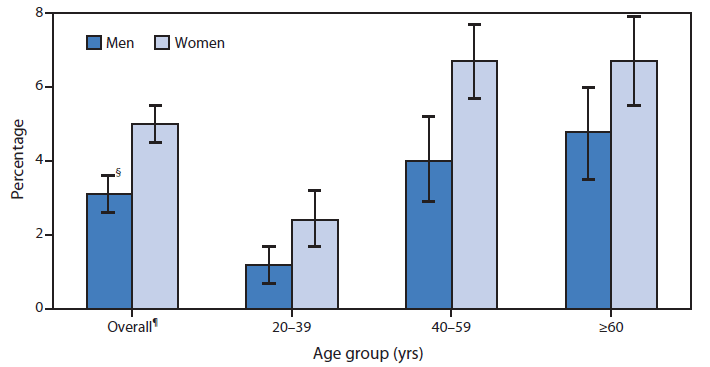Persons using assistive technology might not be able to fully access information in this file. For assistance, please send e-mail to: mmwrq@cdc.gov. Type 508 Accommodation and the title of the report in the subject line of e-mail.
QuickStats: Percentage of Adults Aged ≥20 Years Who Used Prescription Sleep Aids* in the Past 30 Days,† by Age Group and Sex — National Health and Nutrition Examination Survey, United States, 2005–2010

* Includes hypnotic drugs (e.g., butabarbital, chloral hydrate, estazolam, eszopiclone, flurazepam, quazepam, ramelteon, temazepam, triazolam, zaleplon, and zolpidem) and antidepressant drugs with sedative function (e.g., amitriptyline, doxepin, mirtazapine, and trazodone).
† Based on response to the question, "Have you taken or used any medicines for which a doctor's or dentist's prescription is needed in the past month?" Respondents who answered affirmatively were asked to report the name, duration of use, and main reason for each product used.
§ 95% confidence interval.
¶ The overall estimate is age-adjusted to the 2000 projected U.S. standard population using the age groups 20–39, 40–59, and ≥60 years.
During 2005–2010, women were more likely to use a prescription sleep aid than men (5.0% versus 3.1%). Within the three age groups examined, women also were more likely to use a prescription sleep aid than men. For both men and women, adults aged 20–39 years reported lower use of sleep aids than adults aged 40–59 years and ≥60 years.
Source: Chong Y, Fryar CD, Gu Q. Prescription sleep aid use among adults: United States, 2005–2010. NCHS data brief no. 127. Hyattsville, MD: US Department of Health and Human Services, CDC; 2013. Available at http://www.cdc.gov/nchs/data/databriefs/db127.htm.
Reported by: Yinong Chong, PhD, ychong@cdc.gov, 301-458-4145; Steven M. Frenk, PhD.
Alternate Text: The figure above shows the percentage of adults aged ≥20 years who used prescription sleep aids in the past 30 days, by age group and sex, in the United States during 2005-2010. During this period, women were more likely to use a prescription sleep aid than men (5.0% versus 3.1%). Within the three age groups examined, women also were more likely to use a prescription sleep aid than men. For both men and women, adults aged 20-39 years reported lower use of sleep aids than adults aged 40-59 years and ≥60 years.
Use of trade names and commercial sources is for identification only and does not imply endorsement by the U.S. Department of
Health and Human Services.
References to non-CDC sites on the Internet are
provided as a service to MMWR readers and do not constitute or imply
endorsement of these organizations or their programs by CDC or the U.S.
Department of Health and Human Services. CDC is not responsible for the content
of pages found at these sites. URL addresses listed in MMWR were current as of
the date of publication.
All MMWR HTML versions of articles are electronic conversions from typeset documents.
This conversion might result in character translation or format errors in the HTML version.
Users are referred to the electronic PDF version (http://www.cdc.gov/mmwr)
and/or the original MMWR paper copy for printable versions of official text, figures, and tables.
An original paper copy of this issue can be obtained from the Superintendent of Documents, U.S.
Government Printing Office (GPO), Washington, DC 20402-9371;
telephone: (202) 512-1800. Contact GPO for current prices.
**Questions or messages regarding errors in formatting should be addressed to
mmwrq@cdc.gov.
 ShareCompartir
ShareCompartir


